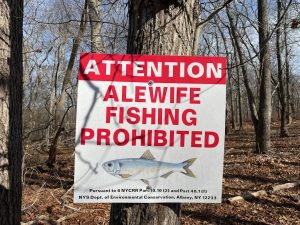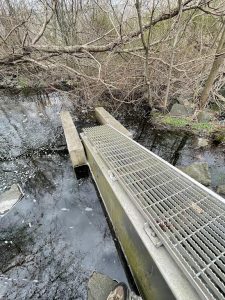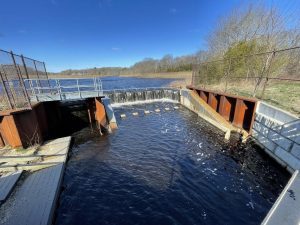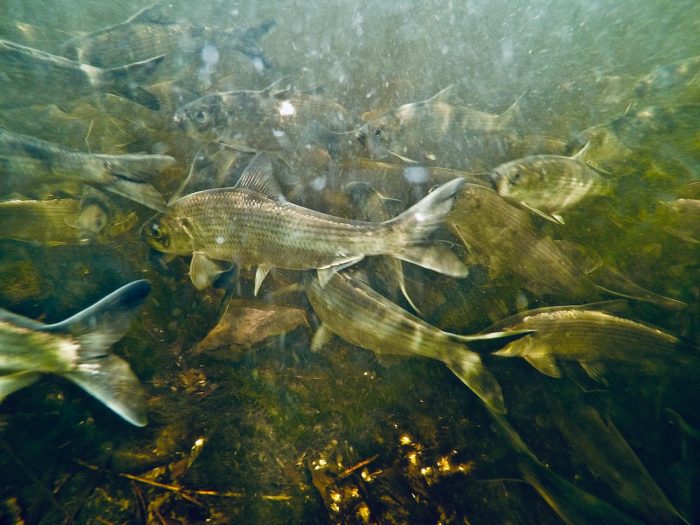Nature Matters: Alewives and Eels – Part 1
By John L. Turner
This is part one of a two-part series on a remarkable pair of fish.
Each Spring, driven by impulses and guided by signals not fully understood, they migrate to Long Island to create the next generation. But unlike red-winged blackbirds, with their bright red shoulder patches and reedlike konk-a-ree calls, or Spring Peepers with their distinctive “sleigh bell” calls ringing from recharge basins and wetlands around Long Island, these migrating animals arrive quietly, their arrival and presence unknown to almost all Long Islanders. And while we may not be aware of their arrival, many other animals like bald eagles, ospreys, otters and great blue herons certainly do.
What animals might they be? Fish — or more precisely alewives (Alosa pseudoharengus) [meaning false herring], a species of river herring, and American Eel (Anguilla rostrata), one of nineteen species of snakelike fish with a worldwide distribution. Alewives return as adults to Long Island waterways, ranging from 9-12 inches long, while eels arrive as “babies,” just several months removed from their birth in the open ocean. Alewives are a shimmering silver in color with a distinctive dark spot behind the gill cover and are almost indistinguishable from their cousin, the blueback herring. When small, eel are translucent, gaining pigment as they mature.

These species are diadromous fish, “dia” meaning “through or across” and “dromous” meaning ”running,” a reference to the migratory habit of these fish moving between the two worlds they inhabit as part of their life cycle — freshwater and saltwater. Alewives and other river herring develop and mature in the salty waters of the North Atlantic, moving into freshwater systems to spawn, while eel typically develop in freshwater and spawn in salt water, in the famous stretch of the mid-Atlantic Ocean known as the Sargasso Sea.
To be more specific, biologists segregate diadromous fish into two other categories: anadromous fish like alewives, other river herring such as American Shad, striped bass, and salmon which mature in salt water but move upstream (“ana” meaning upward) to spawn in freshwater, and catadromous fish (“cat” meaning downward) such as American Eel which develops in freshwater but moves downstream to spawn in salt water.
Schools of alewives, three to four years old, seek out the freshwater stream of their birth, apparently finding their natal stream by its unique and distinctive chemical scent, although fishery biologists are not sure of the precise mechanism they use that allows them to find their way. Once these river herring find suitable habitat they spawn, depositing from tens of thousands to hundreds of thousands of eggs, and the adults soon leave to head back to the ocean. The eggs left behind hatch and the young develop over many weeks before, in mid-summer, heading out to open water too.
Cued by warming waters silvery, shimmering schools of alewives (and smaller numbers of their cousin, blueback herring) arrive in Spring — typically from late March to early May — congregating en masse at the mouths of many streams around Long Island. They then move inland and the “run” has begun! (For a wonderful account of alewife runs and their importance to colonial America, I encourage you to find a copy of The Run by John Hay, published in 1959).

Several hundred years ago the days of “alewife runs” were a time of great excitement for local residents as the fish provided them with an abundance of food at a critical time of year, but also as food for swine, and fertilizer for crops, most notably for “fish corn,” the practice of burying a piece of a fish (often the head) under the planted corn kernel. The rotting fish provided nutrients and minerals to the corn stalk as it grew, a practice originating with Native Americans.
Alewife runs were so important that some of the earliest wildlife laws in the United States were enacted to protect them. A very early law, passed in 1709 in Massachusetts stated: “That no wears [weirs], hedges, fishgarths, kiddles, or other disturbance or encumbrance shall be set, erected or made, on or across any river, to the stopping, obstructing, or straightening of the natural or usual course and the passage of the fish in their seasons, or spring of the year, without the approbiation and allowance first had and obtained from the general sessions of the peace in the same county”. Another law, adopted several decades later in 1741, related directly to the fish: “to prevent the destruction of the fish called alewives, and other fish.”
Their original abundance, especially when contrasted with current levels, was marveled at. John Waldman, a fisheries biologist whose book Running Silver, a wonderful treatise on migratory fish, has noted this abundance by numerous historical references. One account, from 1634, notes: “Alewives came up to the fresh rivers to spawn in such multitudes it is almost incredible, pressing up such shallow waters as will scarce permit them to swim.” Another quote nearly one hundred years later in 1728, noting alewife abundance in Virginia, says: “In a word, it is unbelievable, indeed, undescribable, as also incomprehensible, what quantity is found there. One must behold oneself.” The abundance of alewives today is a tiny and pale shadow of what once existed.
Unfortunately, many obstacles confront alewives and eels today on Long Island as they attempt to move upstream to spawn — not the aforementioned weirs, fishgarths, and kiddles of old, but dams, dams, and more dams (also other structures like poorly designed road and railroad culverts).
Constructed to channel water for the operation of sawmills, grist mills, and woolen mills, and to create impoundments for growing cranberries and harvesting ice, these dams and culverts have almost entirely foreclosed the ability of these fish to pass unimpeded in streams here. The stream at North Sea, Alewife Brook, draining Big Fresh Pond and emptying into North Sea Harbor is one of the very few remaining free-flowing, unimpeded streams remaining on Long Island (and one of the best places to visit to see alewife runs).
The response to solve the dam problem has been the construction of fish ladders or ramps on and around the obstacles. Fish ladders and rock ramps, angled so the fish can make it from the lower stream section to the higher water levels in the upstream impoundment, has proven to be an alternative and somewhat effective strategy for river herring to gain access to spawning areas. To assist eels, pegged boards or tangled rope netting have been deployed which the young eels can wriggle up.

Ladders and ramps have been placed on the main stems of the Peconic and Carmans Rivers, as well as the Swan River in East Patchogue, Massapequa Creek in Massapequa, and another at Betty Allen Park in Huntington. Two important ladders (due to the amount of freshwater the ladders will access) are being constructed — one on the Woodhull Dam in Riverhead providing access to an entire tributary of the Peconic River and another at the base of Mill Pond in Rockville Centre. A ladder is in the planning stage for Bellmore Creek which is expected to be installed in 2023.
A more effective but more controversial solution is dam removal. In many places in the United States dams have been removed but on Long Island this has not been the case as pond-side homeowners fear the loss of their physical and visual access to the water.
One possible area of success is at West Brook within Bayard Cutting Arboretum in Oakdale where the Seatuck Environmental Association has been advocating for the State Parks to not reconstruct the concrete dam that failed on the stream. The dam failure has opened up more than a mile long stretch of West Brook that heretofore was not accessible for migratory fish.
*Part two of this series will appear in the issue of May 12.
A resident of Setauket, John Turner is conservation chair of the Four Harbors Audubon Society, author of “Exploring the Other Island: A Seasonal Nature Guide to Long Island” and president of Alula Birding & Natural History Tours.







